Systematical Characterization of the AT-Hook Gene Family in Juglans regia L. and the Functional Analysis of the JrAHL2 in Flower Induction and Hypocotyl Elongation
Abstract
1. Introduction
2. Results
2.1. AHL Genes in Walnut
2.2. Phylogenetic Analysis of JrAHL Genes
2.3. Gene Structure and Duplication of JrAHLs
2.4. Cis-Acting Element Analysis of JrAHLs Promoter
2.5. Protein-Protein Interaction Analysis JrAHLs
2.6. Gene Expression Patterns of JrAHLs
2.7. Gene Cloning and Subcellular Localization of JrAHL2
2.8. Functional Analysis of JrAHL2 in Transgenic Arabidopsis
3. Discussion
3.1. Identification and Analysis of JrAHL Gene Family Members
3.2. JrAHL2 Delayed Flowering and Inhibited Hypocotyl Elongation
4. Materials and Methods
4.1. Identification of the AHL Gene Family
4.2. Phylogenetic Analysis of AHL Proteins
4.3. Genes and Protein Structure Analysis
4.4. Collinearity Analysis
4.5. Promoter Sequence Analysis
4.6. Interactive Protein Network Analysis
4.7. Expression Profiles of JrAHL Genes
4.8. Quantitative RT-PCR (qRT-PCR)
4.9. Gene Cloning, Vector Construction, and Subcellular Localization
4.10. Plant Transformation and Phenotype Analysis
5. Conclusions
Supplementary Materials
Author Contributions
Funding
Institutional Review Board Statement
Informed Consent Statement
Data Availability Statement
Acknowledgments
Conflicts of Interest
References
- Zhao, J.; Favero, D.S.; Qiu, J.; Roalson, E.H.; Neff, M.M. Insights into the evolution and diversification of the AT-hook Motif Nuclear Localized gene family in land plants. BMC Plant Biol. 2014, 14, 266. [Google Scholar] [CrossRef] [PubMed]
- Zhao, K.; Kas, E.; Gonzalez, E.; Laemmli, U.K. SAR-dependent mobilization of histone H1 by HMG-I/Y in vitro: HMG-I/Y is enriched in H1-depleted chromatin. EMBO J. 1993, 12, 3237–3247. [Google Scholar] [CrossRef] [PubMed]
- Huth, J.R.; Bewley, C.A.; Nissen, M.S.; Evans, J.N.; Reeves, R.; Gronenborn, A.M.; Clore, G.M. The solution structure of an HMG-I(Y)-DNA complex defines a new architectural minor groove binding motif. Nat. Struct. Biol. 1997, 4, 657–665. [Google Scholar] [CrossRef] [PubMed]
- Seo, M.; Lee, J.Y. Dissection of Functional Modules of AT-HOOK MOTIF NUCLEAR LOCALIZED PROTEIN 4 in the Development of the Root Xylem. Front. Plant Sci. 2021, 12, 632078. [Google Scholar] [CrossRef]
- Zhang, W.M.; Cheng, X.Z.; Fang, D.; Cao, J. AT-HOOK MOTIF NUCLEAR LOCALIZED (AHL) proteins of ancient origin radiate new functions. Int. J. Biol. Macromol 2022, 214, 290–300. [Google Scholar] [CrossRef]
- Zhao, J.; Favero, D.S.; Peng, H.; Neff, M.M. Arabidopsis thaliana AHL family modulates hypocotyl growth redundantly by interacting with each other via the PPC/DUF296 domain. Proc. Natl. Acad. Sci. USA 2013, 110, E4688–E4697. [Google Scholar] [CrossRef]
- Xiao, C.; Chen, F.; Yu, X.; Lin, C.; Fu, Y.F. Over-expression of an AT-hook gene, AHL22, delays flowering and inhibits the elongation of the hypocotyl in Arabidopsis thaliana. Plant Mol. Biol. 2009, 71, 39–50. [Google Scholar] [CrossRef]
- Favero, D.S.; Jacques, C.N.; Iwase, A.; Le, K.N.; Zhao, J.; Sugimoto, K.; Neff, M.M. SUPPRESSOR OF PHYTOCHROME B4-#3 Represses Genes Associated with Auxin Signaling to Modulate Hypocotyl Growth. Plant Physiol. 2016, 171, 2701–2716. [Google Scholar] [CrossRef]
- Street, I.H.; Shah, P.K.; Smith, A.M.; Avery, N.; Neff, M.M. The AT-hook-containing proteins SOB3/AHL29 and ESC/AHL27 are negative modulators of hypocotyl growth in Arabidopsis. Plant J. 2008, 54, 1–14. [Google Scholar] [CrossRef]
- Sirl, M.; Snajdrova, T.; Gutierrez-Alanis, D.; Dubrovsky, J.G.; Vielle-Calzada, J.P.; Kulich, I.; Soukup, A. At-Hook Motif Nuclear Localised Protein 18 as a Novel Modulator of Root System Architecture. Int. J. Mol. Sci. 2020, 21, 1886. [Google Scholar] [CrossRef]
- Zhang, S.; Wang, T.; Lima, R.M.; Pettko-Szandtner, A.; Kereszt, A.; Downie, J.A.; Kondorosi, E. Widely conserved AHL transcription factors are essential for NCR gene expression and nodule development in Medicago. Nat. Plants 2023, 9, 280–288. [Google Scholar] [CrossRef]
- Xu, Y.; Gan, E.S.; Ito, T. The AT-hook/PPC domain protein TEK negatively regulates floral repressors including MAF4 and MAF5. Plant Signal. Behav. 2013, 8, e25006. [Google Scholar] [CrossRef]
- Jo, B.S.; Choi, S.S. Introns: The Functional Benefits of Introns in Genomes. Genomics. Inform. 2015, 13, 112–118. [Google Scholar] [CrossRef]
- Jia, Q.S.; Zhu, J.; Xu, X.F.; Lou, Y.; Zhang, Z.L.; Zhang, Z.P.; Yang, Z.N. Arabidopsis AT-hook protein TEK positively regulates the expression of arabinogalactan proteins for Nexine formation. Mol. Plant 2015, 8, 251–260. [Google Scholar] [CrossRef]
- Yun, J.; Kim, Y.S.; Jung, J.H.; Seo, P.J.; Park, C.M. The AT-hook motif-containing protein AHL22 regulates flowering initiation by modifying FLOWERING LOCUS T chromatin in Arabidopsis. J. Biol. Chem. 2012, 287, 15307–15316. [Google Scholar] [CrossRef]
- Favero, D.S.; Kawamura, A.; Shibata, M.; Takebayashi, A.; Jung, J.H.; Suzuki, T.; Jaeger, K.E.; Ishida, T.; Iwase, A.; Wigge, P.A.; et al. AT-Hook Transcription Factors Restrict Petiole Growth by Antagonizing PIFs. Curr. Biol. 2020, 30, 1454–1466.e1456. [Google Scholar] [CrossRef]
- Matsushita, A.; Furumoto, T.; Ishida, S.; Takahashi, Y. AGF1, an AT-hook protein, is necessary for the negative feedback of AtGA3ox1 encoding GA 3-oxidase. Plant Physiol. 2007, 143, 1152–1162. [Google Scholar] [CrossRef]
- Kim, S.Y.; Kim, Y.C.; Seong, E.S.; Lee, Y.H.; Park, J.M.; Choi, D. The chili pepper CaATL1: An AT-hook motif-containing transcription factor implicated in defence responses against pathogens. Mol. Plant Pathol. 2007, 8, 761–771. [Google Scholar] [CrossRef]
- Lu, H.; Zou, Y.; Feng, N. Overexpression of AHL20 negatively regulates defenses in Arabidopsis. J. Integr. Plant Biol. 2010, 52, 801–808. [Google Scholar] [CrossRef]
- Rayapuram, N.; Jarad, M.; Alhoraibi, H.M.; Bigeard, J.; Abulfaraj, A.A.; Volz, R.; Mariappan, K.G.; Almeida-Trapp, M.; Schloffel, M.; Lastrucci, E.; et al. Chromatin phosphoproteomics unravels a function for AT-hook motif nuclear localized protein AHL13 in PAMP-triggered immunity. Proc. Natl. Acad. Sci. USA 2021, 118, e2004670118. [Google Scholar] [CrossRef]
- Wong, M.M.; Bhaskara, G.B.; Wen, T.N.; Lin, W.D.; Nguyen, T.T.; Chong, G.L.; Verslues, P.E. Phosphoproteomics of Arabidopsis Highly ABA-Induced1 identifies AT-Hook-Like10 phosphorylation required for stress growth regulation. Proc. Natl. Acad. Sci. USA 2019, 116, 2354–2363. [Google Scholar] [CrossRef] [PubMed]
- Cai, G.; Kim, S.C.; Li, J.; Zhou, Y.; Wang, X. Transcriptional Regulation of Lipid Catabolism during Seedling Establishment. Mol. Plant 2020, 13, 984–1000. [Google Scholar] [CrossRef] [PubMed]
- Zhou, J.; Wang, X.; Lee, J.Y.; Lee, J.Y. Cell-to-cell movement of two interacting AT-hook factors in Arabidopsis root vascular tissue patterning. Plant Cell 2013, 25, 187–201. [Google Scholar] [CrossRef] [PubMed]
- Gallavotti, A.; Malcomber, S.; Gaines, C.; Stanfield, S.; Whipple, C.; Kellogg, E.; Schmidt, R.J. BARREN STALK FASTIGIATE1 is an AT-hook protein required for the formation of maize ears. Plant Cell 2011, 23, 1756–1771. [Google Scholar] [CrossRef] [PubMed]
- Wang, M.; Chen, B.; Zhou, W.; Xie, L.; Wang, L.; Zhang, Y.; Zhang, Q. Genome-wide identification and expression analysis of the AT-hook Motif Nuclear Localized gene family in soybean. BMC Genomics 2021, 22, 361. [Google Scholar] [CrossRef]
- Zhao, L.; Lu, Y.; Chen, W.; Yao, J.; Li, Y.; Li, Q.; Pan, J.; Fang, S.; Sun, J.; Zhang, Y. Genome-wide identification and analyses of the AHL gene family in cotton (Gossypium). BMC Genom. 2020, 21, 69. [Google Scholar] [CrossRef]
- Zhang, W.M.; Fang, D.; Cheng, X.Z.; Cao, J.; Tan, X.L. Insights Into the Molecular Evolution of AT-Hook Motif Nuclear Localization Genes in Brassica napus. Front. Plant Sci. 2021, 12, 714305. [Google Scholar] [CrossRef]
- Li, X.; He, H.; Wang, H.; Wu, X.; Wang, H.; Mao, J. Identification and expression analysis of the AHL gene family in grape (Vitis vinifera). Plant Gene 2021, 26, 100285. [Google Scholar] [CrossRef]
- Machaj, G.; Grzebelus, D. Characteristics of the AT-Hook Motif Containing Nuclear Localized (AHL) Genes in Carrot Provides Insight into Their Role in Plant Growth and Storage Root Development. Genes 2021, 12, 764. [Google Scholar] [CrossRef]
- Zhang, J.; Zhang, W.; Ji, F.; Qiu, J.; Song, X.; Bu, D.; Pan, G.; Ma, Q.; Chen, J.; Huang, R.; et al. A high-quality walnut genome assembly reveals extensive gene expression divergences after whole-genome duplication. Plant Biotechnol. J. 2020, 18, 1848–1850. [Google Scholar] [CrossRef]
- Bishop, E.H.; Kumar, R.; Luo, F.; Saski, C.; Sekhon, R.S. Genome-wide identification, expression profiling, and network analysis of AT-hook gene family in maize. Genomics 2020, 112, 1233–1244. [Google Scholar] [CrossRef]
- Dahro, B.; Wang, Y.; Khan, M.; Zhang, Y.; Fang, T.; Ming, R.; Li, C.; Liu, J.H. Two AT-Hook proteins regulate A/NINV7 expression to modulate sucrose catabolism for cold tolerance in Poncirus trifoliata. New Phytol. 2022, 235, 2331–2349. [Google Scholar] [CrossRef]
- Zhang, Z.; Quan, S.; Niu, J.; Guo, C.; Kang, C.; Liu, J.; Yuan, X. Genome-Wide Identification, Classification, Expression and Duplication Analysis of bZIP Family Genes in Juglans regia L. Int. J. Mol. Sci. 2022, 23, 5961. [Google Scholar] [CrossRef]
- Zhang, Z.; Quan, S.; Niu, J.; Guo, C.; Kang, C.; Liu, J.; Yuan, X. Comprehensive Identification and Analyses of the GRF Gene Family in the Whole-Genome of Four Juglandaceae Species. Int. J. Mol. Sci. 2022, 23, 12663. [Google Scholar] [CrossRef]
- Karami, O.; Rahimi, A.; Khan, M.; Bemer, M.; Hazarika, R.R.; Mak, P.; Compier, M.; van Noort, V.; Offringa, R. A suppressor of axillary meristem maturation promotes longevity in flowering plants. Nat. Plants 2020, 6, 368–376. [Google Scholar] [CrossRef]
- Aravind, L.; Landsman, D. AT-hook motifs identified in a wide variety of DNA-binding proteins. Nucleic Acids Res. 1998, 26, 4413–4421. [Google Scholar] [CrossRef]
- Castillo-Davis, C.I.; Mekhedov, S.L.; Hartl, D.L.; Koonin, E.V.; Kondrashov, F.A. Selection for short introns in highly expressed genes. Nat. Genet. 2002, 31, 415–418. [Google Scholar] [CrossRef]
- Roy, S.W.; Gilbert, W. The evolution of spliceosomal introns: Patterns, puzzles and progress. Nat. Rev. Genet. 2006, 7, 211–221. [Google Scholar] [CrossRef]
- North, K.; Benbarche, S.; Liu, B.; Pangallo, J.; Chen, S.; Stahl, M.; Bewersdorf, J.P.; Stanley, R.F.; Erickson, C.; Cho, H.; et al. Synthetic introns enable splicing factor mutation-dependent targeting of cancer cells. Nat. Biotechnol. 2022, 40, 1103–1113. [Google Scholar] [CrossRef]
- Panchy, N.; Lehti-Shiu, M.; Shiu, S.H. Evolution of Gene Duplication in Plants. Plant Physiol. 2016, 171, 2294–2316. [Google Scholar] [CrossRef]
- Tjaden, G.; Coruzzi, G.M. A novel AT-rich DNA binding protein that combines an HMG I-like DNA binding domain with a putative transcription domain. Plant Cell 1994, 6, 107–118. [Google Scholar] [CrossRef] [PubMed]
- Karami, O.; Rahimi, A.; Mak, P.; Horstman, A.; Boutilier, K.; Compier, M.; van der Zaal, B.; Offringa, R. An Arabidopsis AT-hook motif nuclear protein mediates somatic embryogenesis and coinciding genome duplication. Nat. Commun. 2021, 12, 2508. [Google Scholar] [CrossRef] [PubMed]
- Liu, H.; Dong, S.; Li, M.; Gu, F.; Yang, G.; Guo, T.; Chen, Z.; Wang, J. The Class III peroxidase gene OsPrx30, transcriptionally modulated by the AT-hook protein OsATH1, mediates rice bacterial blight-induced ROS accumulation. J. Integr Plant Biol. 2021, 63, 393–408. [Google Scholar] [CrossRef] [PubMed]
- Tayengwa, R.; Sharma Koirala, P.; Pierce, C.F.; Werner, B.E.; Neff, M.M. Overexpression of AtAHL20 causes delayed flowering in Arabidopsis via repression of FT expression. BMC Plant Biol. 2020, 20, 559. [Google Scholar] [CrossRef]
- Mistry, J.; Chuguransky, S.; Williams, L.; Qureshi, M.; Salazar, G.A.; Sonnhammer, E.L.L.; Tosatto, S.C.E.; Paladin, L.; Raj, S.; Richardson, L.J.; et al. Pfam: The protein families database in 2021. Nucleic. Acids Res. 2021, 49, D412–D419. [Google Scholar] [CrossRef]
- Chou, K.C.; Shen, H.B. Cell-PLoc: A package of Web servers for predicting subcellular localization of proteins in various organisms. Nat. Protoc. 2008, 3, 153–162. [Google Scholar] [CrossRef]
- Kumar, S.; Stecher, G.; Tamura, K. MEGA7: Molecular Evolutionary Genetics Analysis Version 7.0 for Bigger Datasets. Mol. Biol. Evol. 2016, 33, 1870–1874. [Google Scholar] [CrossRef]
- Li, L.; Stoeckert, C.J., Jr.; Roos, D.S. OrthoMCL: Identification of ortholog groups for eukaryotic genomes. Genome Res. 2003, 13, 2178–2189. [Google Scholar] [CrossRef]
- Wang, Y.; Tang, H.; Debarry, J.D.; Tan, X.; Li, J.; Wang, X.; Lee, T.H.; Jin, H.; Marler, B.; Guo, H.; et al. MCScanX: A toolkit for detection and evolutionary analysis of gene synteny and collinearity. Nucleic Acids Res. 2012, 40, e49. [Google Scholar] [CrossRef]
- Krzywinski, M.; Schein, J.; Birol, I.; Connors, J.; Gascoyne, R.; Horsman, D.; Jones, S.J.; Marra, M.A. Circos: An information aesthetic for comparative genomics. Genome. Res. 2009, 19, 1639–1645. [Google Scholar] [CrossRef]
- Zhang, Z. KaKs_Calculator 3.0: Calculating Selective Pressure on Coding and Non-coding Sequences. Genom. Proteom. Bioinform. 2022, 20, 536–540. [Google Scholar] [CrossRef]
- Chen, C.; Chen, H.; Zhang, Y.; Thomas, H.R.; Frank, M.H.; He, Y.; Xia, R. TBtools: An Integrative Toolkit Developed for Interactive Analyses of Big Biological Data. Mol. Plant 2020, 13, 1194–1202. [Google Scholar] [CrossRef]
- Fang, H.; Liu, X.; Dong, Y.; Feng, S.; Zhou, R.; Wang, C.; Ma, X.; Liu, J.; Yang, K.Q. Transcriptome and proteome analysis of walnut (Juglans regia L.) fruit in response to infection by Colletotrichum gloeosporioides. BMC Plant Biol. 2021, 21, 249. [Google Scholar] [CrossRef]
- Ji, F.; Ma, Q.; Zhang, W.; Liu, J.; Feng, Y.; Zhao, P.; Song, X.; Chen, J.; Zhang, J.; Wei, X.; et al. A genome variation map provides insights into the genetics of walnut adaptation and agronomic traits. Genome. Biol. 2021, 22, 300. [Google Scholar] [CrossRef]
- Livak, K.J.; Schmittgen, T.D. Analysis of relative gene expression data using real-time quantitative PCR and the 2(-Delta Delta C(T)) Method. Methods 2001, 25, 402–408. [Google Scholar] [CrossRef]
- Jia, P.; Xing, L.; Zhang, C.; Zhang, D.; Ma, J.; Zhao, C.; Han, M.; Ren, X.; An, N. MdKNOX19, a class II knotted-like transcription factor of apple, plays roles in ABA signalling/sensitivity by targeting ABI5 during organ development. Plant Sci. 2021, 302, 110701. [Google Scholar] [CrossRef]
- Zhang, X.; Henriques, R.; Lin, S.S.; Niu, Q.W.; Chua, N.H. Agrobacterium-mediated transformation of Arabidopsis thaliana using the floral dip method. Nat. Protoc. 2006, 1, 641–646. [Google Scholar] [CrossRef]
- Jia, P.; Xing, L.B.; Zhang, C.G.; Chen, H.; Li, Y.M.; Zhang, D.; Ma, J.J.; Zhao, C.P.; Han, M.Y.; Ren, X.L.; et al. MdKNOX15, a class I knotted-like transcription factor of apple, controls flowering and plant height by regulating GA levels through promoting the MdGA2ox7 transcription. Environ. Exp. Bot. 2021, 185, 104411. [Google Scholar] [CrossRef]
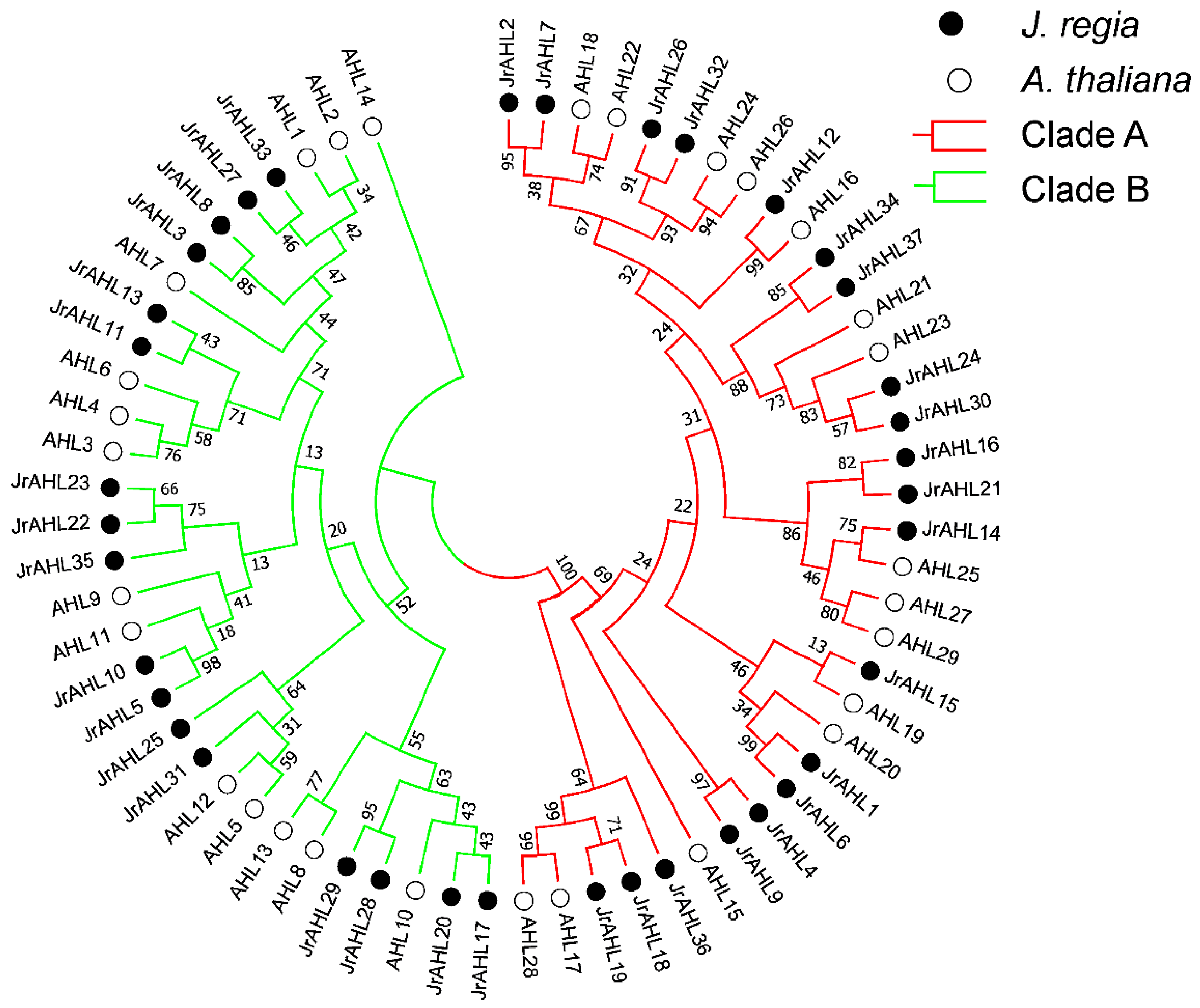
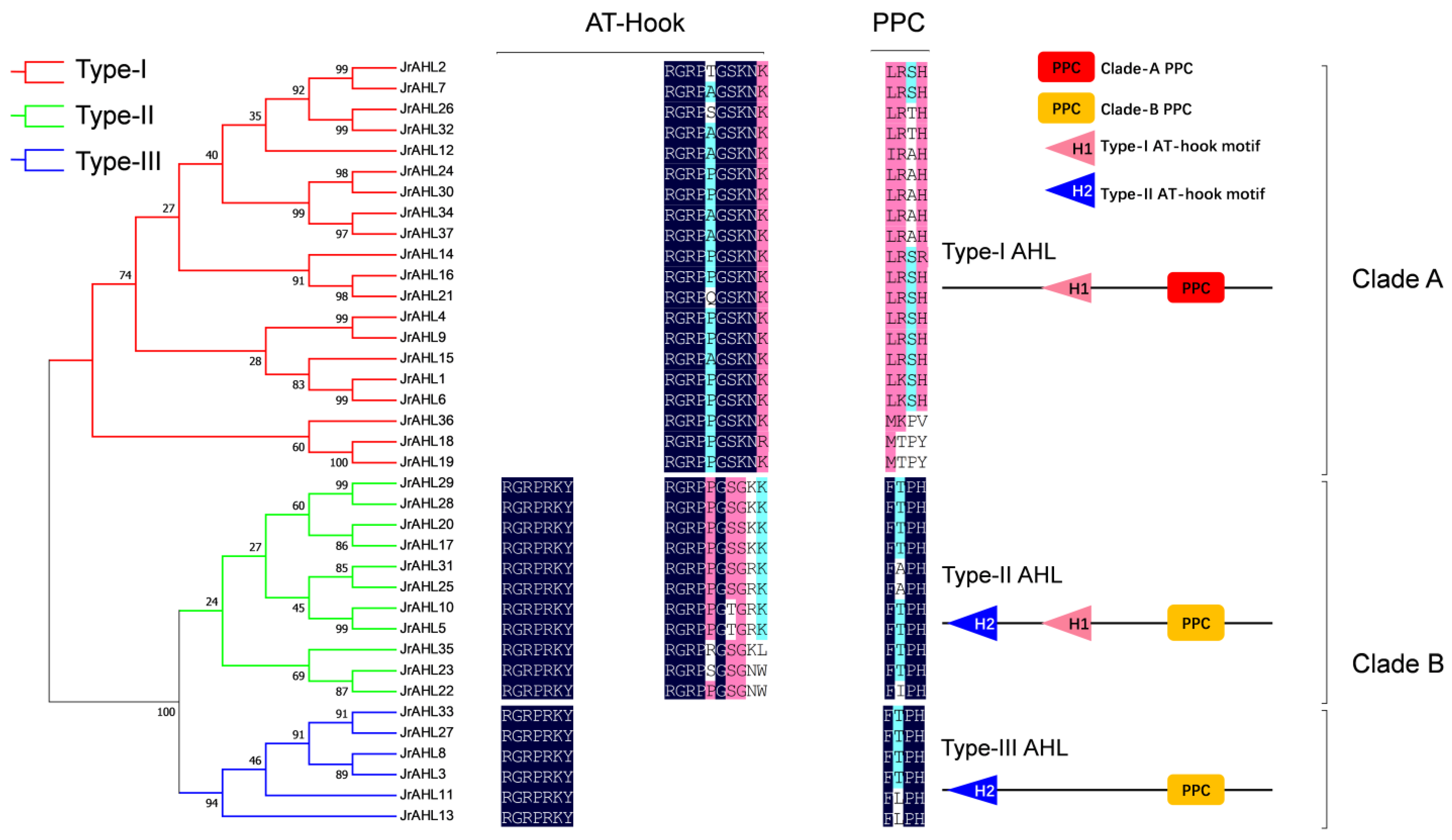


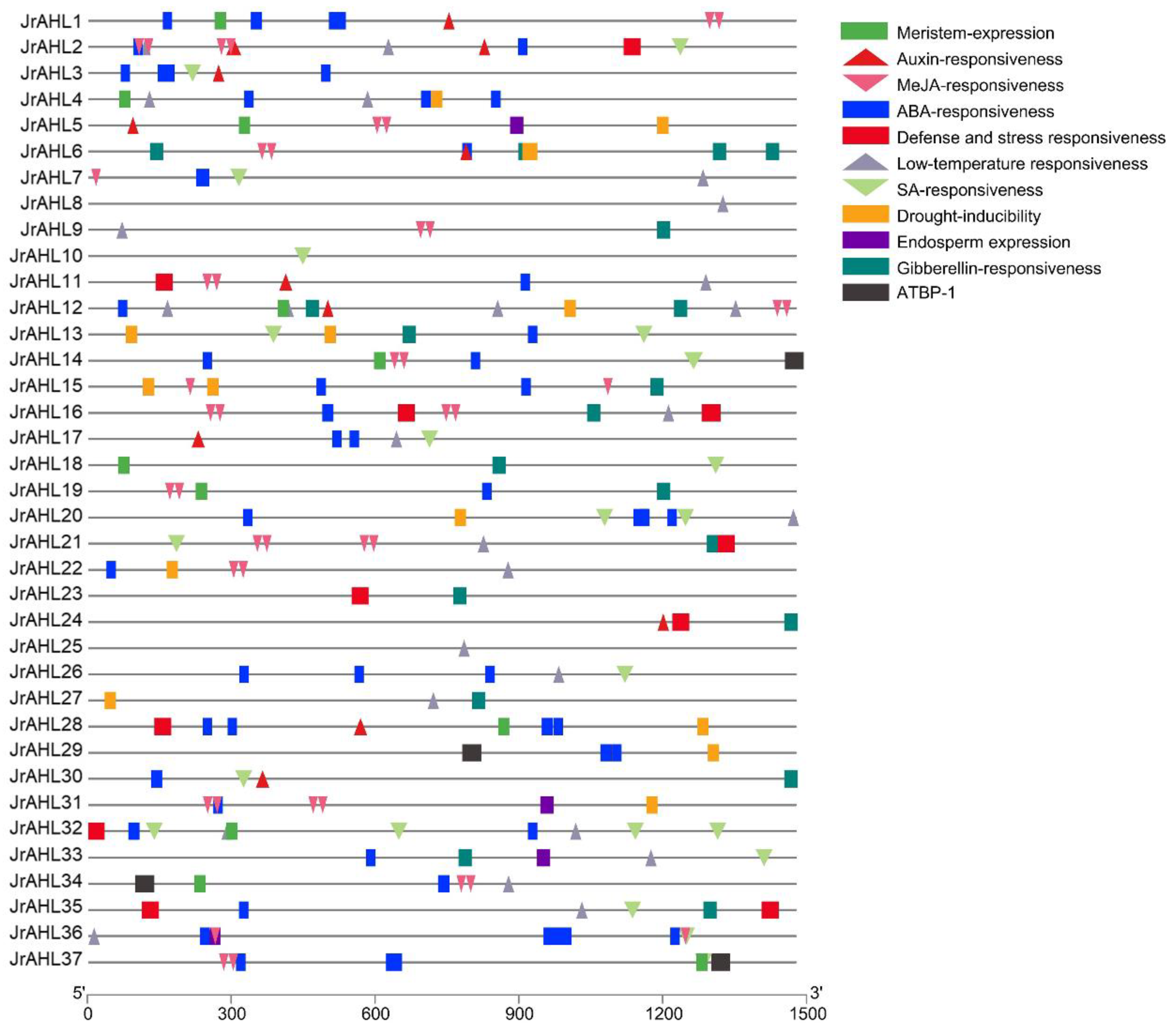
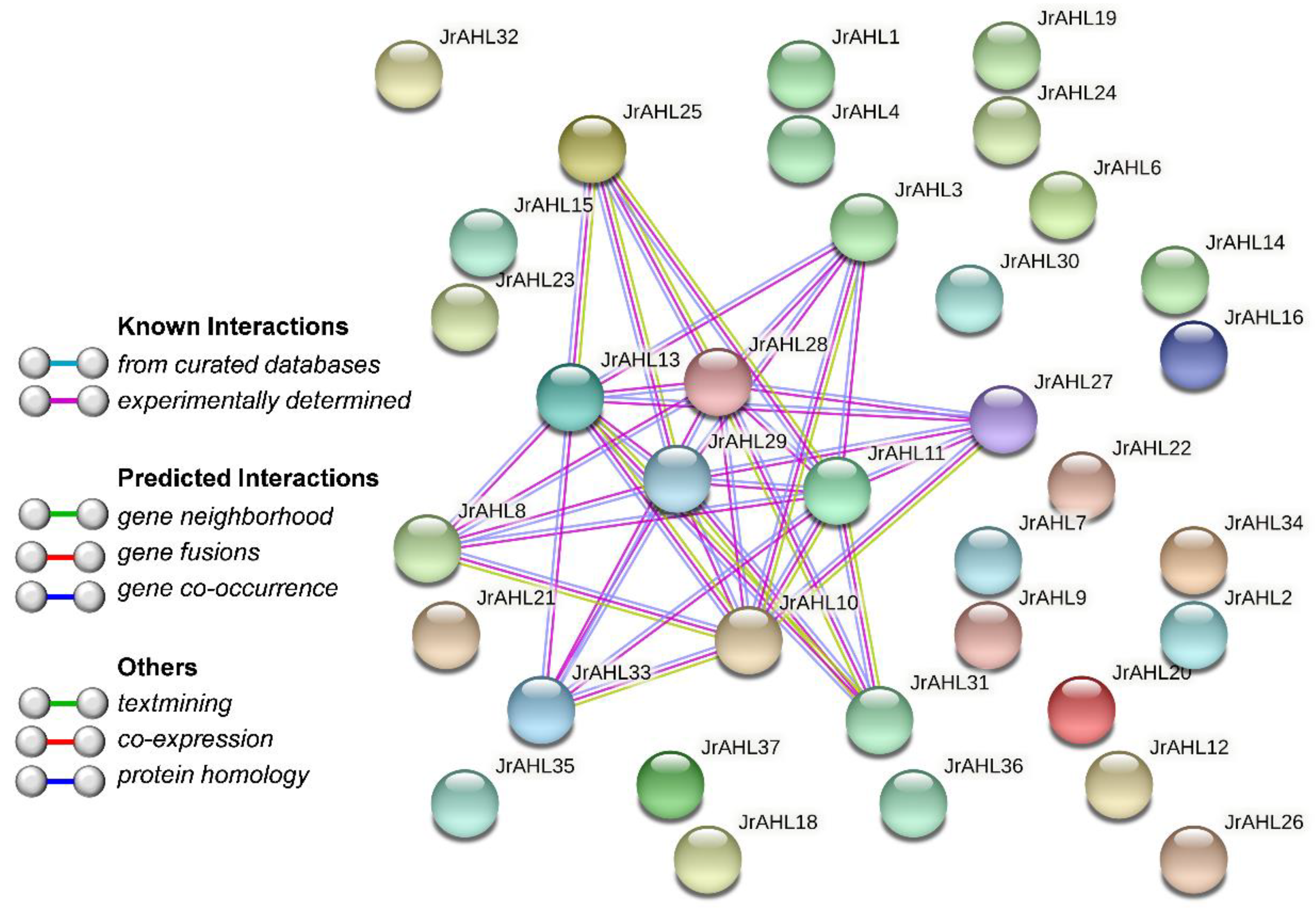
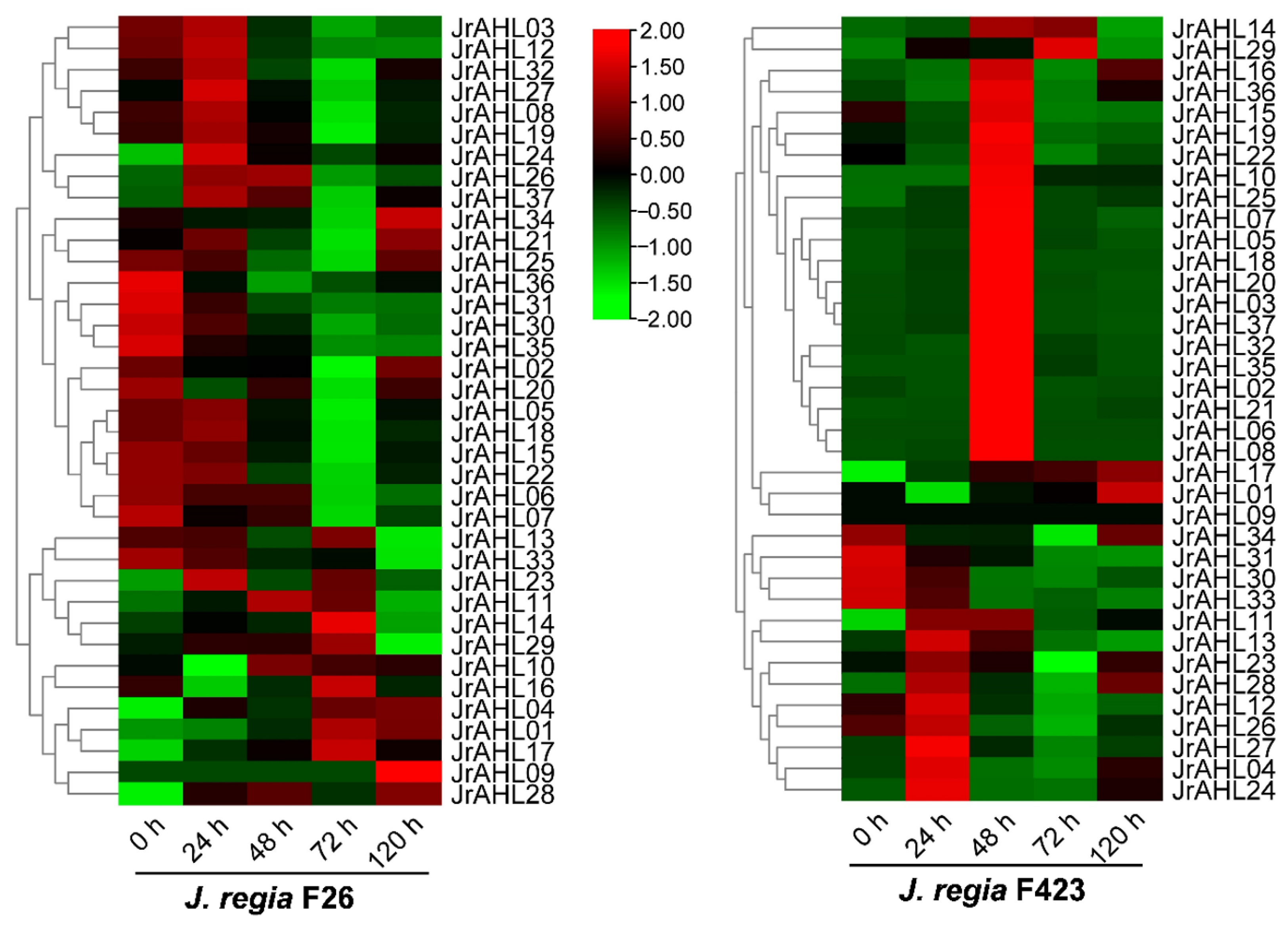
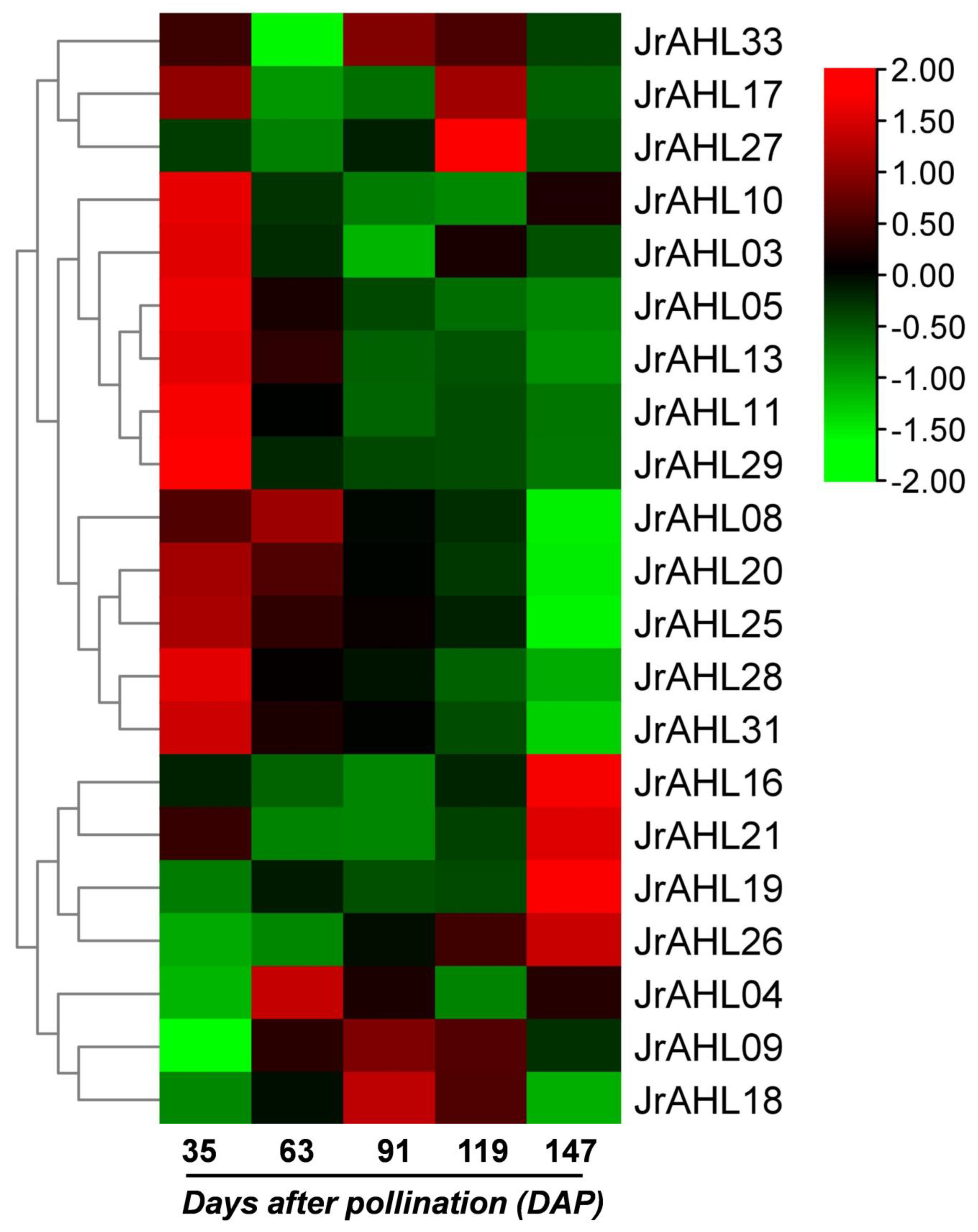
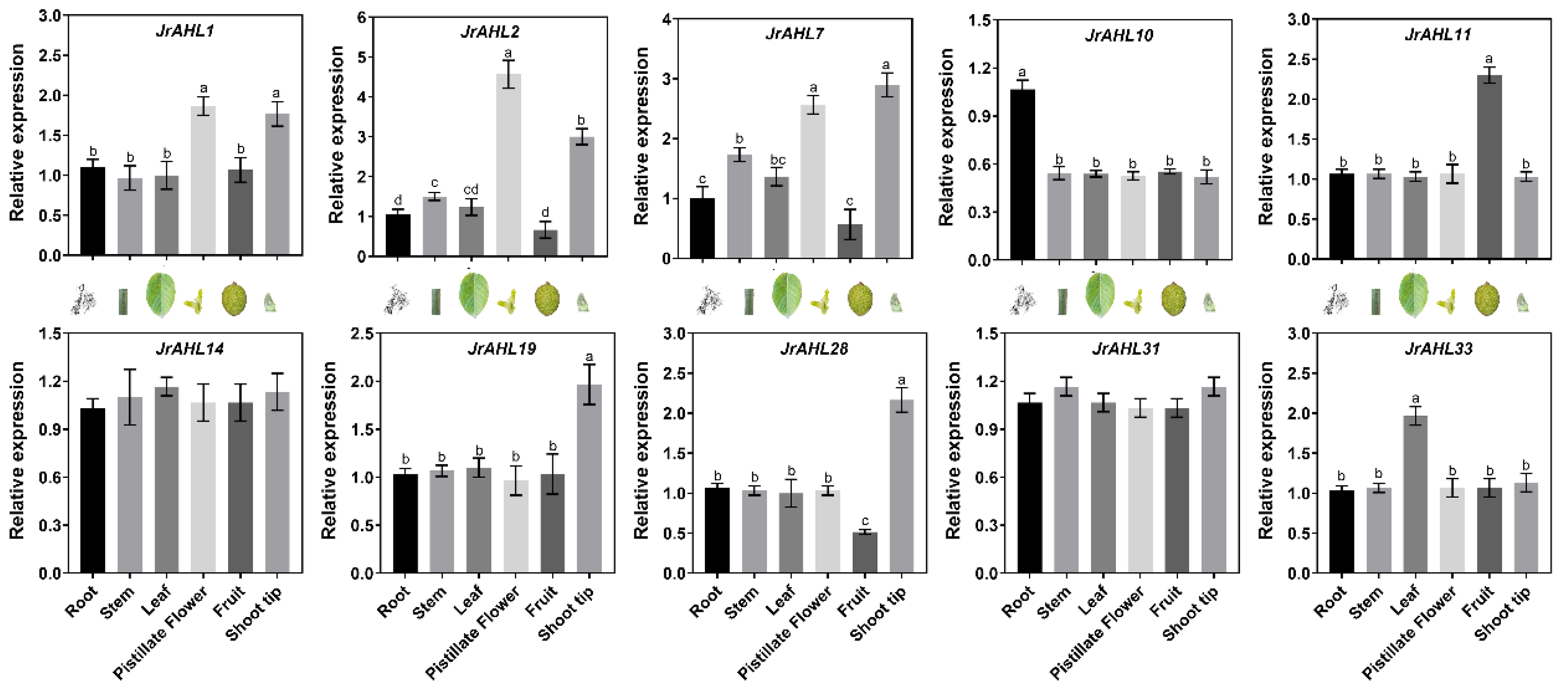
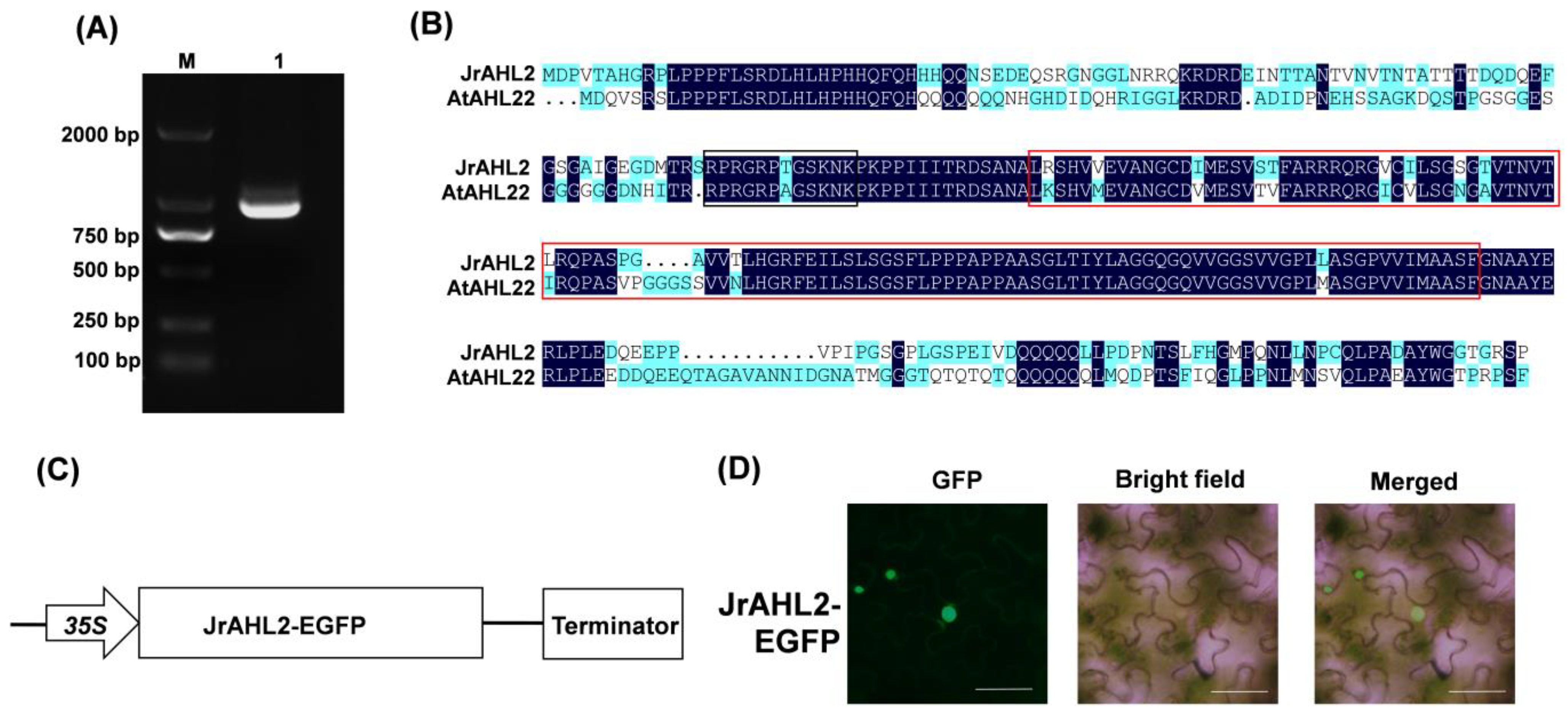
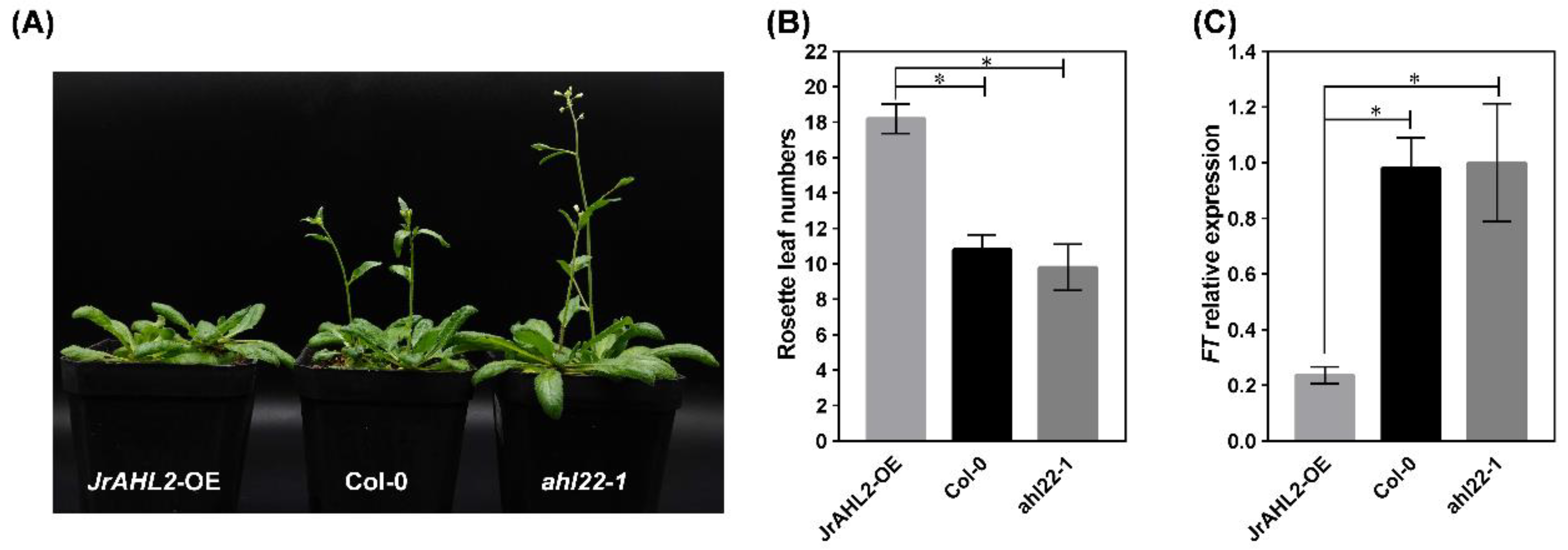
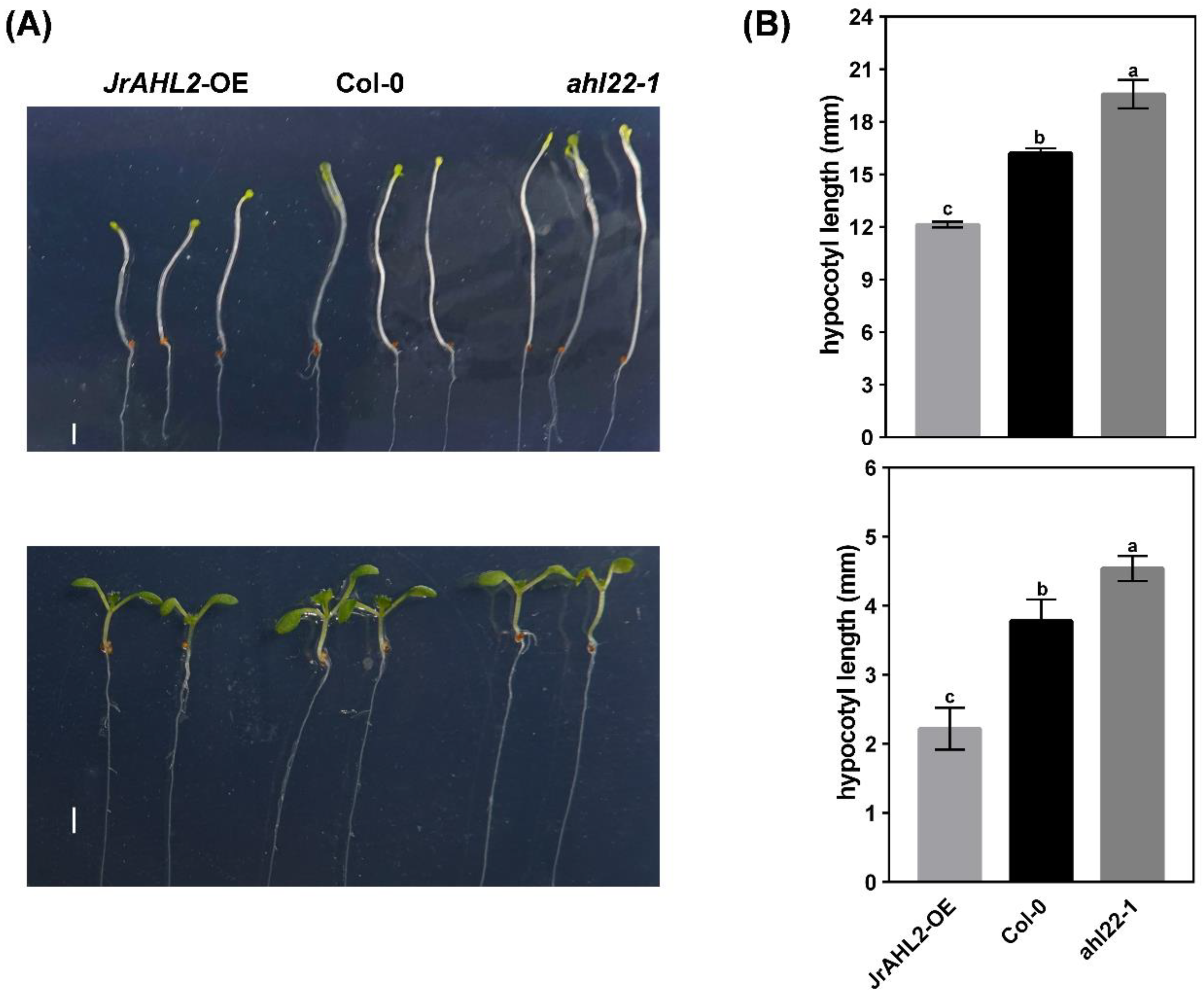
| Name | Gene ID | Location (Start) | Location (End) | Strand | Length | CDS (bp) | Peptide (aa) | pI | MW (kDa) |
|---|---|---|---|---|---|---|---|---|---|
| JrAHL1 | JreChr01G12984 | 39,611,176 | 39,611,994 | + | 819 | 819 | 272 | 6.08 | 28.02 |
| JrAHL2 | JreChr01G12992 | 47,390,686 | 47,391,612 | − | 927 | 927 | 308 | 6.59 | 32.84 |
| JrAHL3 | JreChr01G13333 | 47,470,900 | 47,477,455 | + | 6556 | 1005 | 334 | 9.59 | 34.79 |
| JrAHL4 | JreChr01G13761 | 50,056,338 | 50,057,327 | − | 990 | 990 | 329 | 5.08 | 34.44 |
| JrAHL5 | JreChr02G10898 | 7,160,919 | 7,167,725 | − | 6807 | 1035 | 344 | 9.91 | 35.36 |
| JrAHL6 | JreChr02G11467 | 21,601,290 | 21,602,144 | + | 855 | 855 | 284 | 6.45 | 29.38 |
| JrAHL7 | JreChr02G11474 | 26,318,938 | 26,319,843 | − | 906 | 906 | 301 | 6.80 | 31.86 |
| JrAHL8 | JreChr02G11687 | 26,371,944 | 26,376,879 | + | 4936 | 1068 | 355 | 8.83 | 36.83 |
| JrAHL9 | JreChr02G11978 | 27,859,904 | 27,860,884 | − | 981 | 981 | 326 | 5.60 | 34.15 |
| JrAHL10 | JreChr03G13350 | 4,426,812 | 4,430,966 | − | 4155 | 795 | 264 | 10.46 | 27.04 |
| JrAHL11 | JreChr04G10741 | 8,368,413 | 8,372,787 | + | 4375 | 1014 | 337 | 9.21 | 35.15 |
| JrAHL12 | JreChr04G12210 | 20,642,675 | 20,643,481 | + | 807 | 807 | 268 | 9.24 | 28.25 |
| JrAHL13 | JreChr06G10970 | 6,003,983 | 6,011,773 | + | 7791 | 930 | 309 | 9.61 | 32.44 |
| JrAHL14 | JreChr07G10387 | 23,875,413 | 23,876,234 | − | 822 | 822 | 273 | 9.74 | 28.01 |
| JrAHL15 | JreChr07G11230 | 16,643,389 | 16,644,297 | − | 909 | 909 | 302 | 5.77 | 31.30 |
| JrAHL16 | JreChr07G11239 | 27,147,611 | 27,148,277 | − | 667 | 666 | 221 | 10.09 | 23.04 |
| JrAHL17 | JreChr07G11616 | 27,252,429 | 27,256,966 | + | 4538 | 1107 | 368 | 10.09 | 36.49 |
| JrAHL18 | JreChr08G11927 | 30,383,998 | 30,384,978 | + | 981 | 981 | 326 | 7.07 | 34.60 |
| JrAHL19 | JreChr08G12220 | 5,871,308 | 5,872,264 | − | 957 | 957 | 318 | 6.36 | 33.92 |
| JrAHL20 | JreChr08G12225 | 8,400,985 | 8,408,164 | − | 7180 | 1182 | 393 | 10.33 | 39.80 |
| JrAHL21 | JreChr09G12239 | 8,457,851 | 8,459,672 | + | 1822 | 696 | 231 | 9.87 | 23.85 |
| JrAHL22 | JreChr10G11635 | 644,863 | 648,220 | + | 3358 | 1089 | 362 | 8.49 | 37.48 |
| JrAHL23 | JreChr11G10743 | 358,990 | 361,864 | + | 2875 | 1068 | 355 | 9.12 | 36.87 |
| JrAHL24 | JreChr11G11355 | 23,940,903 | 23,941,778 | − | 876 | 876 | 291 | 5.96 | 30.42 |
| JrAHL25 | JreChr11G11477 | 30,455,540 | 30,459,915 | + | 4376 | 1017 | 338 | 10.61 | 35.04 |
| JrAHL26 | JreChr11G11481 | 31,577,477 | 31,578,376 | − | 900 | 900 | 299 | 6.16 | 32.00 |
| JrAHL27 | JreChr12G10636 | 31,622,448 | 31,628,198 | + | 5751 | 939 | 312 | 9.63 | 31.89 |
| JrAHL28 | JreChr12G10638 | 18,010,455 | 18,017,606 | + | 7152 | 1134 | 377 | 9.37 | 38.78 |
| JrAHL29 | JreChr12G10640 | 18,021,521 | 18,027,959 | − | 6439 | 1140 | 379 | 9.59 | 38.92 |
| JrAHL30 | JreChr12G10998 | 18,039,195 | 18,040,085 | − | 891 | 891 | 296 | 6.10 | 31.07 |
| JrAHL31 | JreChr12G11092 | 21,387,711 | 21,392,430 | + | 4720 | 1020 | 339 | 10.00 | 35.22 |
| JrAHL32 | JreChr12G11095 | 22,118,819 | 22,119,700 | − | 882 | 882 | 293 | 6.30 | 31.42 |
| JrAHL33 | JreChr13G10464 | 22,173,675 | 22,179,704 | + | 6030 | 1221 | 406 | 9.59 | 42.63 |
| JrAHL34 | JreChr13G10846 | 1,739,954 | 1,740,790 | − | 837 | 837 | 278 | 5.80 | 28.67 |
| JrAHL35 | JreChr13G10963 | 23,001,456 | 23,006,865 | − | 5410 | 963 | 320 | 9.73 | 33.66 |
| JrAHL36 | JreChr14G10308 | 24,429,650 | 24,430,551 | − | 902 | 795 | 264 | 6.37 | 26.99 |
| JrAHL37 | JreChr01G12984 | 1,416,877 | 1,417,719 | − | 843 | 843 | 280 | 6.04 | 29.02 |
Disclaimer/Publisher’s Note: The statements, opinions and data contained in all publications are solely those of the individual author(s) and contributor(s) and not of MDPI and/or the editor(s). MDPI and/or the editor(s) disclaim responsibility for any injury to people or property resulting from any ideas, methods, instructions or products referred to in the content. |
© 2023 by the authors. Licensee MDPI, Basel, Switzerland. This article is an open access article distributed under the terms and conditions of the Creative Commons Attribution (CC BY) license (https://creativecommons.org/licenses/by/4.0/).
Share and Cite
Jia, P.; Liu, J.; Yan, R.; Yang, K.; Dong, Q.; Luan, H.; Zhang, X.; Li, H.; Guo, S.; Qi, G. Systematical Characterization of the AT-Hook Gene Family in Juglans regia L. and the Functional Analysis of the JrAHL2 in Flower Induction and Hypocotyl Elongation. Int. J. Mol. Sci. 2023, 24, 7244. https://doi.org/10.3390/ijms24087244
Jia P, Liu J, Yan R, Yang K, Dong Q, Luan H, Zhang X, Li H, Guo S, Qi G. Systematical Characterization of the AT-Hook Gene Family in Juglans regia L. and the Functional Analysis of the JrAHL2 in Flower Induction and Hypocotyl Elongation. International Journal of Molecular Sciences. 2023; 24(8):7244. https://doi.org/10.3390/ijms24087244
Chicago/Turabian StyleJia, Peng, Jiale Liu, Rui Yan, Kaiyu Yang, Qinglong Dong, Haoan Luan, Xuemei Zhang, Han Li, Suping Guo, and Guohui Qi. 2023. "Systematical Characterization of the AT-Hook Gene Family in Juglans regia L. and the Functional Analysis of the JrAHL2 in Flower Induction and Hypocotyl Elongation" International Journal of Molecular Sciences 24, no. 8: 7244. https://doi.org/10.3390/ijms24087244
APA StyleJia, P., Liu, J., Yan, R., Yang, K., Dong, Q., Luan, H., Zhang, X., Li, H., Guo, S., & Qi, G. (2023). Systematical Characterization of the AT-Hook Gene Family in Juglans regia L. and the Functional Analysis of the JrAHL2 in Flower Induction and Hypocotyl Elongation. International Journal of Molecular Sciences, 24(8), 7244. https://doi.org/10.3390/ijms24087244





